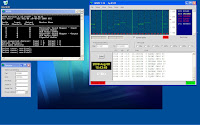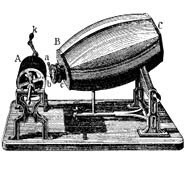 This month's Practical Wireless makes reference to something called the Joule Thief circuit which allows a very nearly exhausted single cell battery to run a white LED. The article is in G3RJV's regular column. The nifty circuit only needs 4 parts. For a video describing how to build this, see this YouTube item. Another useful resource is http://www.emanator.demon.co.uk/bigclive/joule.htm from which this image was taken.
This month's Practical Wireless makes reference to something called the Joule Thief circuit which allows a very nearly exhausted single cell battery to run a white LED. The article is in G3RJV's regular column. The nifty circuit only needs 4 parts. For a video describing how to build this, see this YouTube item. Another useful resource is http://www.emanator.demon.co.uk/bigclive/joule.htm from which this image was taken.
10 Aug 2009
Joule Thief circuit
 This month's Practical Wireless makes reference to something called the Joule Thief circuit which allows a very nearly exhausted single cell battery to run a white LED. The article is in G3RJV's regular column. The nifty circuit only needs 4 parts. For a video describing how to build this, see this YouTube item. Another useful resource is http://www.emanator.demon.co.uk/bigclive/joule.htm from which this image was taken.
This month's Practical Wireless makes reference to something called the Joule Thief circuit which allows a very nearly exhausted single cell battery to run a white LED. The article is in G3RJV's regular column. The nifty circuit only needs 4 parts. For a video describing how to build this, see this YouTube item. Another useful resource is http://www.emanator.demon.co.uk/bigclive/joule.htm from which this image was taken.
Labels:
Joule thief,
LED
6m JT6M reception
A year or two back, during the winter months, I listened to European 6m DX via random meteor showers using the digital mode JT6M, listening on 50.230MHz. Even though I only have a V2000 triband vertical, I heard several countries then with the best DX being EA, I and HA listening for about 30 minutes in the evening. This week there is a meteor shower due around Aug 12th (Perseids?) so I will give it another go to see what can be heard with my basic setup and antenna.
At the moment I don't think it is worth trying to TX as the most I can run is 10W.
At the moment I don't think it is worth trying to TX as the most I can run is 10W.
8 Aug 2009
WSPR Success
 DH5RAE (990kms away) logged my 5W into just the 10m band halo TXing WSPR on 30m a few minutes ago. So, the system is now fully working, despite the appalling antenna for 30m. Then in the next timeslot I was received by OH2BMH (1759kms away). WSPR is going to be one heck of a lot of fun on bands like 10m and 6m with QRP when the bands open up.
DH5RAE (990kms away) logged my 5W into just the 10m band halo TXing WSPR on 30m a few minutes ago. So, the system is now fully working, despite the appalling antenna for 30m. Then in the next timeslot I was received by OH2BMH (1759kms away). WSPR is going to be one heck of a lot of fun on bands like 10m and 6m with QRP when the bands open up.LATER: In three sessions of "30m WSPR beacon
 ing" I've now been received in 5 European countries at distances between 594 and 1759kms. The image on the left is of my WSPR log.
ing" I've now been received in 5 European countries at distances between 594 and 1759kms. The image on the left is of my WSPR log.
More WSPRing
Well, thanks to some help from others I've figured out how to TX a WSPR signal.
For use with a SignaLink USB interface and VOXing TX you need 0, 2, 4 as the settings for PTT, RX and TX and you need to restart the WSPR program for the changes to take effect (this was my problem).
For use with a SignaLink USB interface and VOXing TX you need 0, 2, 4 as the settings for PTT, RX and TX and you need to restart the WSPR program for the changes to take effect (this was my problem).
Labels:
wspr
7 Aug 2009
WSPR DXing
My best WSPR report tonight was of DL6NL who was running just 50mW on 7MHz. I could receive him OK at 733kms when using my 10m band halo antenna.
WSPRing
 Today I made my first foray into WSPR mode (Weak Signal Propagation Reporting).
Today I made my first foray into WSPR mode (Weak Signal Propagation Reporting).I've managed to decode WSPR signals on 30m and 40m OK, but every time I tried to TX with the program it bombs out and wants to send Microsoft an error message. I'm using a SignaLink USB interface (working fine on PSK31) and have set the WSPR PTT option to "0", which should allow VOX operation on TX via the SignaLink USB interface rather than via a COM port. Anyone know why this fails to work and crashes the program?
WSPR is a mode which allows specially encoded very weak signals to be decoded and then the resulting report uploaded to a central database. So, for example, you TX with a QRP mW signal on 10MHz and someone receives the WSPR message. Using the software, a report appears on the internet, so you know how far the signal reached.
See http://www.g4ilo.com/wspr.html for a good introduction to WSPR. Spots (uploaded by the program or manually to the internet) can be seen at http://wsprnet.org/meptspots.php
Labels:
SignaLink USB,
wspr
5 Aug 2009
6m CW
Last night I heard TF2JB weakly calling CQ on 6m CW on an otherwise empty band, but I did not work him. This afternoon at 5pm I called CQ on 6m CW having heard the SK3SIX beacon pop up out of the noise and was answered by SM2GCQ. So, even with 5W, a CQ can get a QSO on 6m in an almost empty band. Spor-E is still around folks, if less frequent than a month or so ago.
3 Aug 2009
LY3LP's blogsite
This is a very interesting blogsite with lots to interest QRPers. I like the tunnel diode TX and the 6m projects. Some of the wind turbine blades are unusual. See http://sa555.blogspot.com/
Labels:
ly3lp
2 Aug 2009
1860 voice recordings
 I missed this news from March 2008 about the earliest recordings of the human voice made in France in the late 1850s and early 1860s. American researchers pieced together a 10sec audio clip of a French folk song which they believe is the oldest recognisable recording of the human voice. A young woman sings from the 18th century folk song Au Clair de la Lune. It was made in 1860 by Edouard Scott de Martinville on a device he called a phonautograph. Listen to the sound clip here:
I missed this news from March 2008 about the earliest recordings of the human voice made in France in the late 1850s and early 1860s. American researchers pieced together a 10sec audio clip of a French folk song which they believe is the oldest recognisable recording of the human voice. A young woman sings from the 18th century folk song Au Clair de la Lune. It was made in 1860 by Edouard Scott de Martinville on a device he called a phonautograph. Listen to the sound clip here:http://graphics8.nytimes.com/audiosrc/arts/1860v2.mp3
Edison's recording of himself reciting 'Mary had a little lamb' were many years LATER than these very early recordings. Totally fascinating!
Labels:
old voice recording,
phonautograph
1 Aug 2009
Pye PF1 and PF8 handhelds
 I've justed added a couple of pages to my website on two Pye Telecom PMR products I had involvement with in my early days in the development labs there.
I've justed added a couple of pages to my website on two Pye Telecom PMR products I had involvement with in my early days in the development labs there.See Pye Telecom PF1 Handhelds and Pye Telecom PF8 Handheld
For far more information on Pye Telecom see the website http://www.pyetelecomhistory.org/
Incidentally there is a drive to set up a permanent museum of radio history in the Cambridge area in which Pye Telecom products would be featured. £30k is needed to get this project off the ground. See the Pye Telecom History pages for more information on this project.
Labels:
pf1,
pf8,
pye telecom
Subscribe to:
Posts (Atom)


